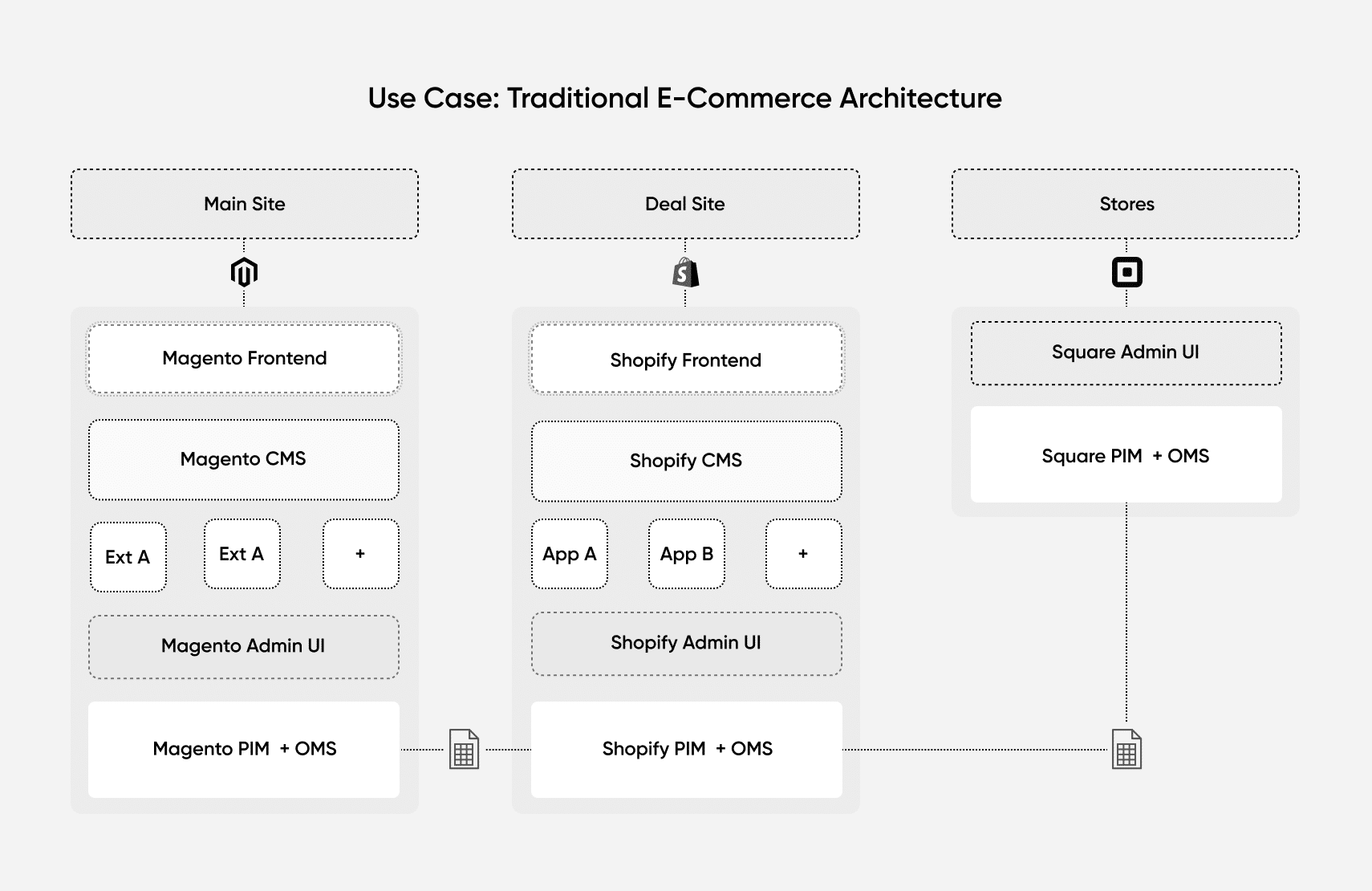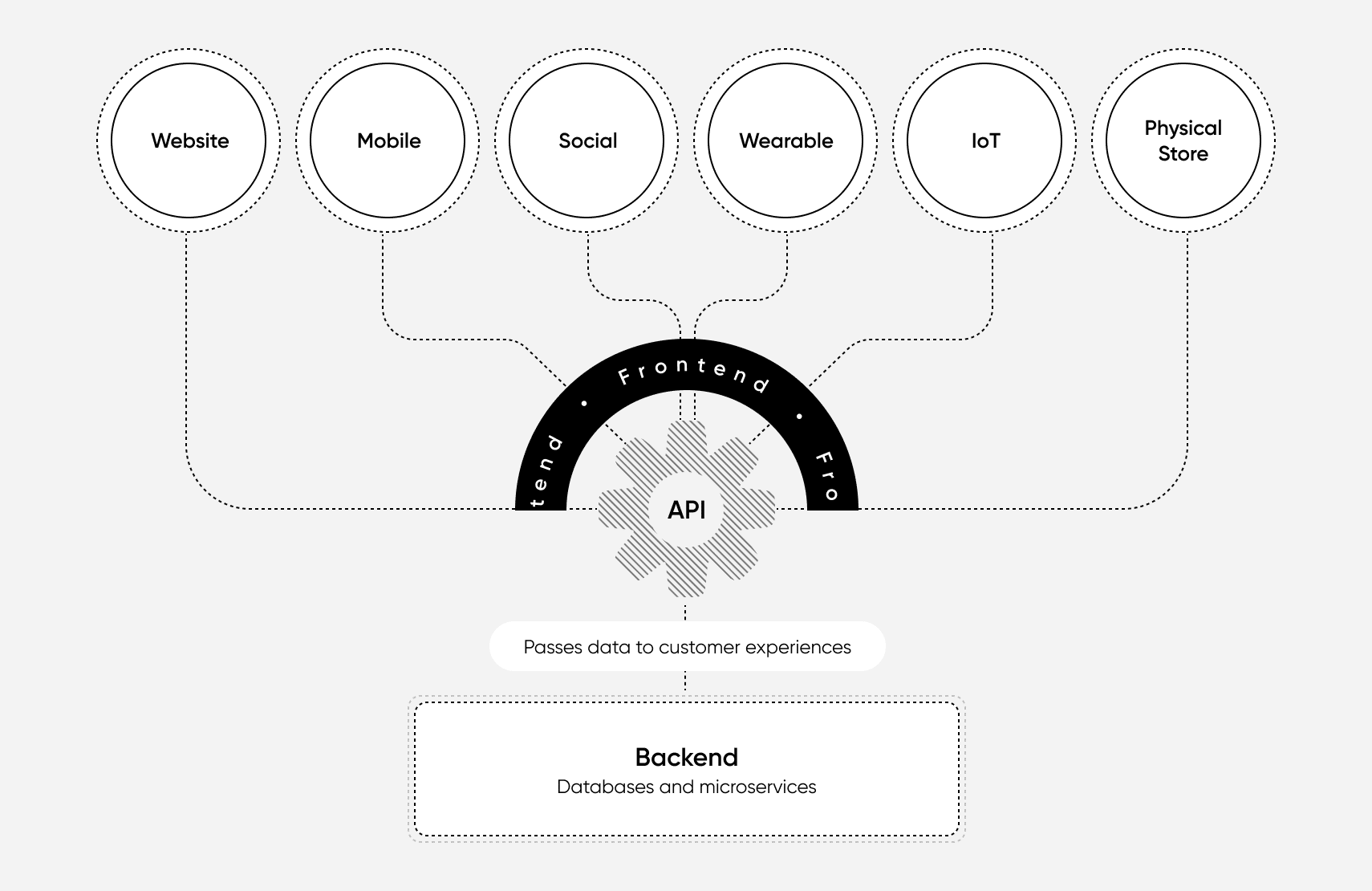Building a Scalable E-Commerce Architecture with Microservices
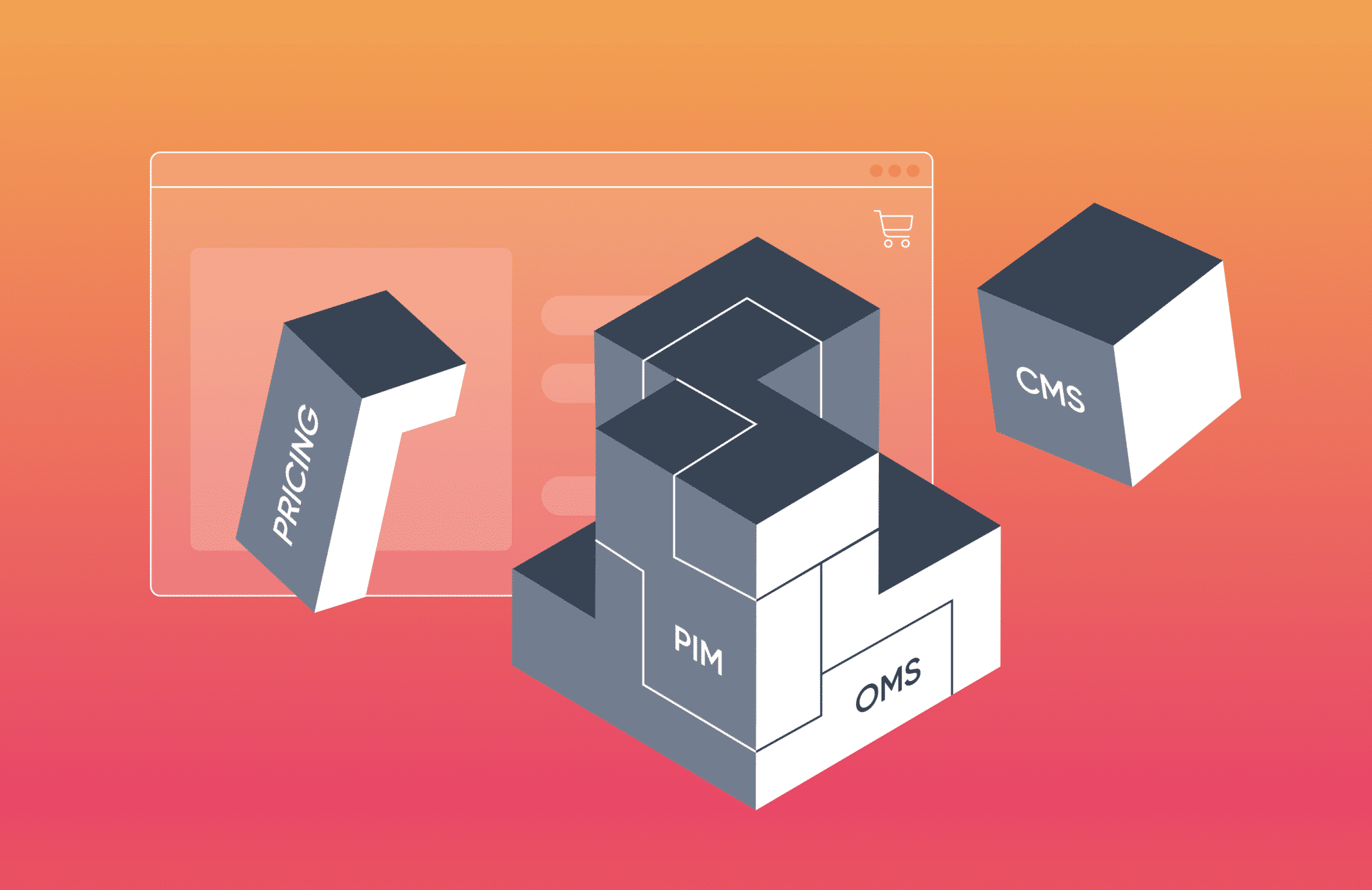
Platforms such as Shopify and Salesforce Commerce Cloud have monolithic software architectures that are not scalable.
You can build an e-commerce architecture that supports rapid growth and unique customer experiences with microservices.
Microservices come from third-party providers or in-house engineering teams and power specific commerce functionality.
You can avoid risky a replatforming project and gradually move from a monolith to microservices with the strangler pattern.
Many major online retailers use e-commerce architectures built with all-in-one platforms such as Shopify, Magento, and Salesforce Commerce Cloud to launch e-commerce websites. These platforms, also called monolithic platforms, combine business services like product information management, order management, pricing, and other e-commerce functionality into a rigid system to simplify site deployment and management. However, in doing so, they sacrifice the flexibility and scalability required to meet the demands of a growing business.
A more scalable e-commerce architecture is achievable by using distinct commerce services that are called microservices-based or service-oriented architectures (SOAs). These services are isolated e-commerce applications that handle unique e-commerce business functions and communicate with each other using APIs.
With this type of e-commerce architecture, businesses can upscale, downscale, and replace individual functions without breaking the entire e-commerce architecture. They can also introduce a headless CMS to use their website architecture to power other channels of commerce such as mobile apps, points of sale, and social media platforms. This practice is called headless commerce and, paired with SOA, is the best way to scale commerce. After all, this is how Amazon scaled commerce.
Traditional vs modern e-commerce architecture
With traditional, monolithic e-commerce architectures, it’s impossible to modify individual e-commerce functions without compromising the entire system. Something as simple as upscaling infrastructure for a product launch or holiday weekend can require months of preparation.
With modern, service-oriented e-commerce architectures, brands don’t need months to prepare for an event that only lasts a few days. They can also update, upscale, or enhance individual services within their tech stack without jeopardizing the entire system.
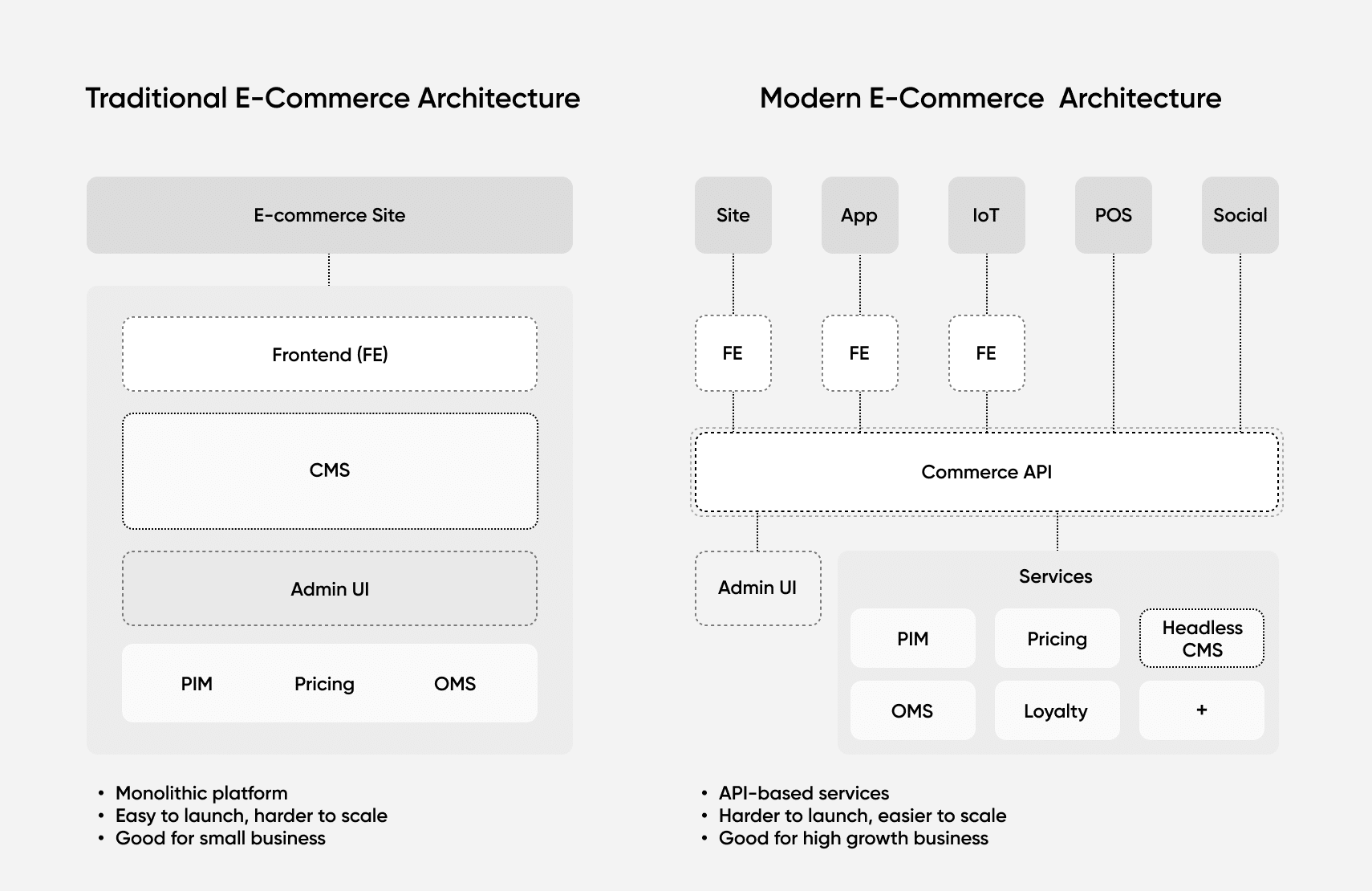
Diagram (right): In a modern e-commerce architecture, a “headless” commerce API is used as a data communication layer to power multiple sales channels or heads. Services like the product information manager (PIM) and order management system (OMS) are separate, scalable services and connected through APIs. The headless CMS functions as another scalable service that provides the content to infinite channels.
While some monolithic commerce platforms offer the ability to decouple the frontend from the backend and make the system headless, the backend remains unscalable. In the rest of this article, I’ll walk you through the high-level steps needed to create a scalable e-commerce website architecture using microservices rather than a traditional monolith.
[toc-embed headline=”Step 1: Review Your Current E-Commerce Architecture”]
Step 1: Review Your Current E-Commerce Architecture
Before designing a microservices e-commerce architecture, it’s essential to review existing architecture to identify existing software and challenges. This will help you map priorities, determine technical capabilities, and effectively plan for the new architecture.
Let’s take a look at an unscalable, traditional architecture that many high-growth brands use in niche verticals. First, we’ll review the software, then we’ll highlight some challenges with the software and the e-commerce architecture. Use the same approach during your review, complete with a high-level diagram like the one below.
The software this brand uses includes:
- Magento website: The brand uses this platform to power its main e-commerce site. It chose Magento because it’s free and relatively easy to use. However, more and more Magento extensions are used over time.
- Shopify side site: The brand launched a daily deals site on Shopify since connecting another sales channel to Magento was not intuitive. However, this led to inventory and fulfillment issues.
- Square in-store POS: This is the first technology the brand purchased when it launched its in-store business. Magento and Shopify were added later on.
The biggest software-related challenges this brand faces include:
- Overselling occurs because Shopify, Magento, and the POS do not communicate with one order management system (OMS).
- Productivity declines because offline conversations, paperwork, and patchy Magento extensions are required to make the system work.
- The brand needs additional resources for data entry since connecting channels require manual data entry in spreadsheets or Quickbooks.
- Magento extensions and Shopify apps cause single points of failure; installing, uninstalling, or updating them can bring down the entire system.
Clearly defining your existing architecture, software, and challenges like this is imperative for setting up a new approach to a service-oriented e-commerce architecture that’s more scalable.
[toc-embed headline=”Step 2: Build or Buy E-Commerce Microservices”]
Step 2: Build or Buy E-Commerce Microservices
Once you understand your existing architecture and business needs, it’s time to choose an approach to replace it that does not require an expensive and risky replatforming project. The primary choice at this stage is between building or buying commerce microservices, applications, and APIs.
Best practice is to build microservices for differentiating features that are specific to your unique business and buy microservices for necessary features from software providers like fabric. An example of a differentiating feature is a room builder for a home decor e-commerce company. Examples of necessary features include catalog management, cart, pricing, and checkout.
Building e-commerce microservices
Building a complete microservices architecture for e-commerce in-house is only viable for an enterprise with complex needs. A custom solution can be more expensive to build and maintain. So, unless you’re a billion-dollar enterprise like Amazon, it’ll probably end up being more trouble than it’s worth.
However, there are some microservices you will want to build in-house. One popular way for building custom e-commerce applications is with Amazon elastic container services (ECS). This is a service that lets you quickly launch, exit, or manage docker containers on a cluster. Amazon ECS maintains the application’s availability, allowing users to scale containers when necessary.
Developers at e-commerce brands can also build their own system using Docker. Docker packages individual applications into Docker containers and uses tools such as Kubernetes and Portainer to manage and scale containerized applications (i.e. microservices). Further, you can use tools such as Kong or Ocelot to act as API gateway and help backend microservices communicate with frontend client devices.
As you can see, there are many tools required to build e-commerce microservices in-house. Besides creating and managing service containers, developers and operation teams need to configure applications to handle load balancing, service discovery, logging, monitoring, and tracing. That’s a lot of overhead. If the company isn’t careful, it can have many distributed monoliths in its e-commerce architecture.
Buying e-commerce microservices
Another way to build a scalable e-commerce architecture is by using commerce services and APIs from third-party providers. This approach can help brands architect a microservices-based infrastructure while simplifying service management. Below is a simple e-commerce infrastructure diagram that demonstrates a microservices-based architecture using a service provider like fabric.
Backend: There are a robust set of apps that includes a PIM, OMS, and pricing engine that come with a user interface for business users. These modular, independent applications are equipped with APIs to provide as much flexibility as custom applications.
API: To orchestrate data and events between the frontend and backend, brands must have an API middle layer. This layer allows them to move away from monolithic architectures by “microservicing” elements of their tech stack one at a time instead of all together.
Frontend: The frontend is managed by a headless CMS that supports multiple frameworks like Angular, React, and Vue to build reusable components. It lets you control the entire frontend shopping experience by integrating commerce services via APIs.
Third-party providers give the flexibility needed to design a future-proof e-commerce architecture. It lets retailers add, remove, and modify individual microservices within their architecture without risking the entire system and building the microservices themselves.
[toc-embed headline=”Step 3: Break Down Your Monolithic Architecture”]
Step 3: Break Down Your Monolithic Architecture
After finalizing the new architecture, it’s time to move away from the old, legacy commerce platform. While there are many modern-day design patterns, it’s best to use the strangler pattern to migrate to a modern, service-oriented platform. This approach helps you move away from a monolith by replacing one component at a time. It minimizes the risk of project failure during migration and distributes the development effort needed.
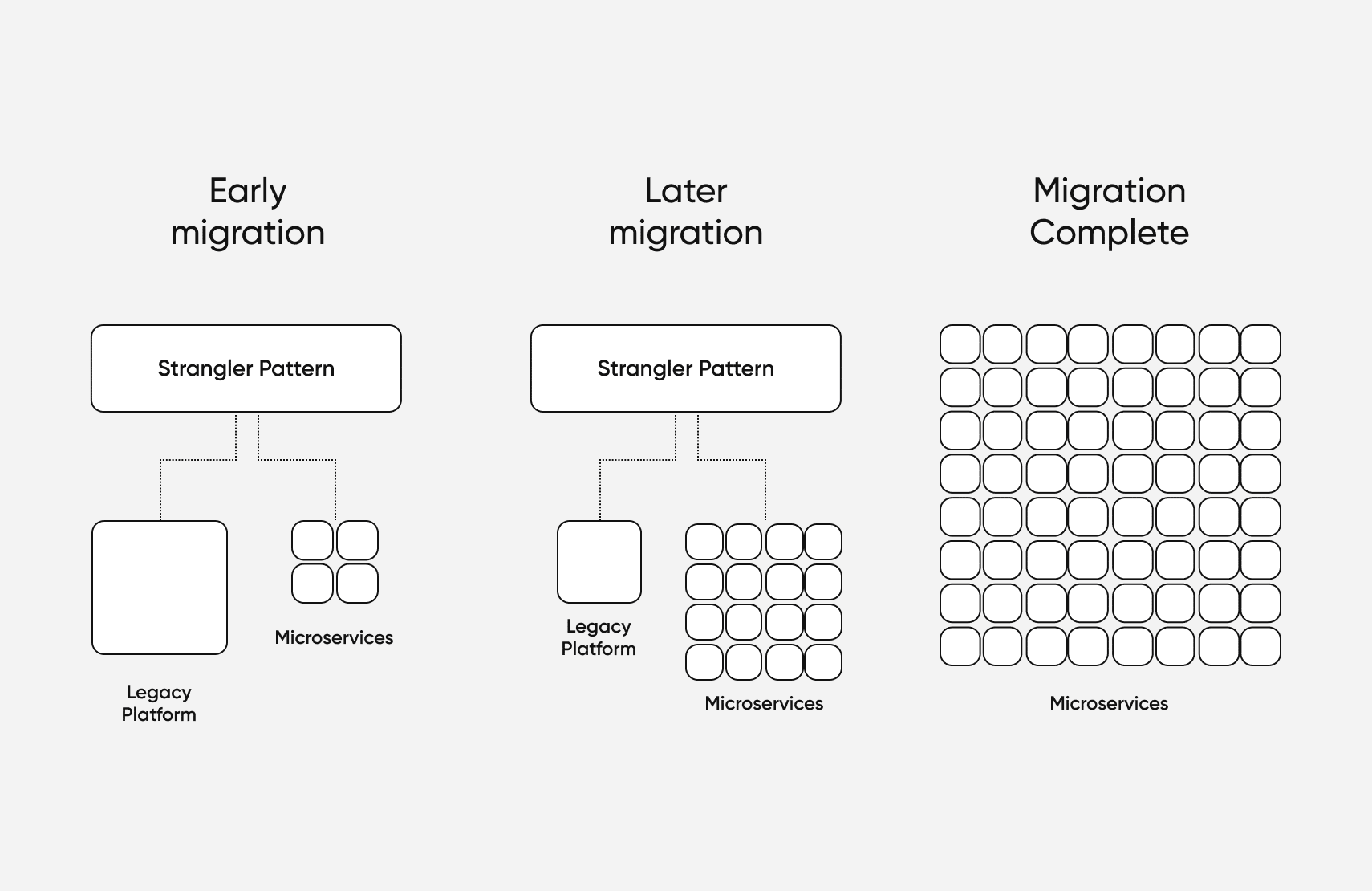
Legacy platforms such as Magento, Shopify, and Oracle ATG let you separate the frontend and e-commerce backend with APIs. E-commerce businesses can leverage this and use API calls to pull data onto a modern frontend like fabric XM or replace individual backend commerce components with microservices such as Stripe for payments, Algolia for search, and fabric PIM for inventory.
Let’s assume a brand wants to start with migrating the catalog in its monolithic e-commerce platform to a modular, service-oriented PIM. The first step is to export all product data in a format that’s compatible with the new microservices-based system. Then you need to parse and import it into the new database. The actual process will vary based on the choice of service and database. However, here’s a sample Node script that uses the XmlStream library:
const fs = require('fs')
const XmlStream = require('xml-stream') ;
const stream=fs.createReadStream(catalog.xml');
const xml = new XmlStream(stream);
xml.preserve('product-id', true);
xml.collect('product');
xml.on('endElement: product-id', function(item) {
saveToDatabase(item);
});It’s worth pointing out that things can still go wrong despite the best efforts. Even the slightest error during migration can result in failure. However, this is fixable by using a managed message queueing service such as Amazon SQS that lets you configure retry policies to handle common errors.
Failure causes are often highly variable, and there’s no set way to overcome them. So make sure you reference Amazon’s documentation to configure message queues for your system and use case.
[toc-embed headline=”Step 4: Rally Support Around the New Architecture”]
Step 4: Rally Support Around the New Architecture
Engineers and developers can craft solid implementation ideas and migration strategies to deploy a microservice architecture. However, they’ll likely need the entire organization’s support, including C-level executives and board of directors at some level during the project.
A recent MIT Sloan Management report reveals that every successful digital transformation demands that leaders transform themselves digitally first. Adopting a new e-commerce architecture is unlikely to be effective without leadership embracing and championing the modern, scalable e-commerce approach. Key stakeholders and business executives must be ready for the changes and long-term commitment of this new, modern architecture.
Also, the development team must believe enough in the idea to “light up” the rest of the organization. Because adopting a microservice architecture requires more deployable units, it takes more effort to implement. So it’s much harder to scale without the whole team on board. The engineering team should show key departments why a microservices system is far more scalable and easier to customize, as well as the preparations and the commitment needed to implement it effectively.
Following this step and other steps outlined above will position your company for long-term success without bringing ongoing activities across merchandising, marketing, and development to a standstill.

Digital content editorial team @ fabric
